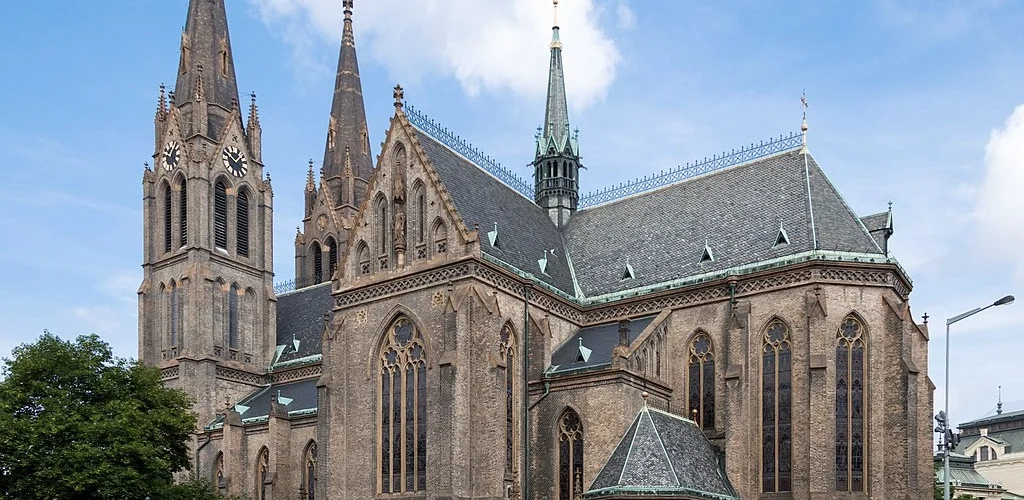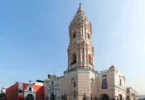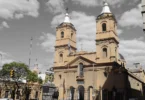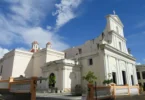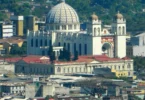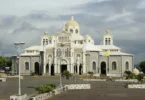Introduction
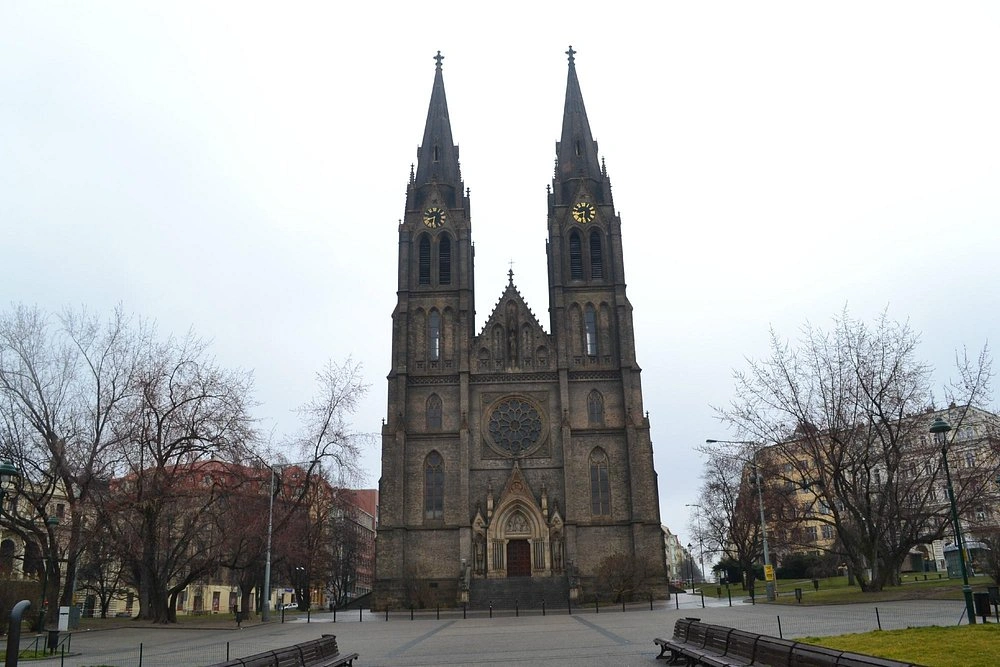
The Basilica of St. Ludmila is a Roman Catholic church over at Náměstí Míru (that’s Peace Square) in the Vinohrady neighborhood of Prague 2. It’s a big neo-Gothic building that was put up in the late 1800s to honor Princess Ludmila, who’s actually a saint. Even though it looks old and grand, it’s one of the younger churches in that part of Prague only younger one there is the Cathedral of the Sacred Heart of Jesus. Back in the day, Vinohrady was just a small village. But in 1879, it officially became a city, and with more and more people moving in a lot of them Catholic they needed a proper church. The city planners had a clear layout in mind: they wanted the central square to have three main buildings a church, a theater, and a national community center. The church’s spot was already picked out right in the middle, lined up with the main west-east street. Architect Josef Mocker was the guy brought in to design it.
Construction started in 1888 and wrapped up by 1892. The church is made of brick and has three main aisles with a cross-shaped layout. The front is super recognizable two tall towers (each just over 60 meters high), some big bells, and a detailed entrance with sculptures above it. Inside, the place is full of color from the stained glass, along with a bunch of paintings and sculptures. Some pretty well-known Czech artists worked on it, like Josef Václav Myslbek, Josef Capek, and Frantisek Zenisek. In the ’70s and ’80s, the church had a rough time. It had to close down first because of Metro construction, then for major renovations. They started fixing it up in 1980, and by the end of 1984, they reopened part of it for Mass, even if it was just a temporary setup. Finally, on September 16, 1992 which is the feast day of St. Ludmila the whole church reopened with a big ceremony led by Cardinal Miloslav Vlk. The following year, in September 1993, the bells rang once more. The area surrounding the church is now bustling with activity, especially during open-air concerts, Christmas and Easter markets, and other charity events. Since 2013, there’s even been a cool videomapping show projected on the church every October as part of the Signal Festival. And just recently, in August 2022, Pope Francis officially gave it the title of minor basilica a big honor in the Catholic world.

Vinohrady really started to grow in 1875, when they tore down a portion of the New Town walls from the Poské embankment to the Blind Gate. What used to be just a quiet area quickly turned into a proper Prague neighborhood, with new apartment buildings going up in line with the city’s zoning plans. The people of Vinohrady initially belonged to the St. Nicholas parish over in Vrsovice. Aside from two little chapels one was the Chapel of the Holy Family above the Nusle stairs, and the other was the Chapel of St. Wenceslas at the orphanage run by the Borromean Sisters there wasn’t really a church of their own. However, Vinohrady’s population had reached 15,000 by 1881, indicating that it required its own parish and church. So the mayor at the time, Vilém Vlcek (you might also see it written Wilhelm Wlczek), kicked off the whole idea. On November 1, 1884, the new parish was officially created.The project got a lot of help from local groups like the Vinohrady trade associations, a women’s union called St. Eliska’s, and a group originally called the Society for the Support of the Church of the Lord (later renamed the Society of St. Ludmila). Vlcek was even elected as curator in 1885. The foundation stone was laid on November 25, 1888. Construction lasted until 1892, based on plans by architect Josef Mocker though František Mikš oversaw the actual building work. Some of the top artists of the time worked on decorating the church. It was officially consecrated on Sunday, October 8, 1893, by Prague Archbishop Cardinal Frantisek Schönborn. After that, they brought in relics of St. Ludmila and St. Wenceslas in a big ceremonial procession. The church’s interior was still being worked on into the early 1900s for example, the main altar wasn’t commissioned until 1902. Altogether, the church cost about 369,922 Austrian gulden to build (that’s 276,482 for the building itself and 93,440 for all the decorations and artwork inside).
Later on, the parish added a Marian chapel inside the Provincial Maternity Hospital at Karlov. That one was shut down during the communist era in the mid-1950s, but thankfully reopened after 1990. The church went through a rough patch starting in 1974. It had to close because of the metro construction, and then stayed closed even longer for renovations. At one point, they opened just a small part of one nave so people could at least gather for Mass, even in a makeshift setup. Finally, in 1992, the whole church reopened with a big ceremony led by Cardinal Miloslav Vlk. These days, Namesti Miru the square right in front of the church is a popular spot for all kinds of events. You’ll see Christmas and Easter markets, concerts, and community activities happening throughout the year. And since 2013, the church has been one of the main highlights of the Signal Festival they do a stunning video mapping projection on the building every October.
In September 2024, they celebrated the 140th anniversary of the parish. The big event took place on September 16, which is also the feast day of St. Ludmila she was a princess, martyr, grandmother of St. Wenceslas, and patron saint of mothers and grandmothers. During the celebration, the parish gave out the “St. Ludmila’s Scarf” award for the fourth time. This year, it went to the former Archbishop of Prague, Cardinal Dominik Duka, for his work in honoring St. Ludmila’s legacy. The ceremony brought out some big names including current Archbishop Jan Graubner, the Vatican’s ambassador Archbishop Jude Thaddeus Okolo, and Prague’s mayor Bohuslav Svoboda. Over the years, a bunch of well-known people have either worked with the parish or visited it now and then. Some of them, sadly, have passed like actress Simona Postlerova, actor and director Jan Kacer, ballet master Vlastimil Harapes, and singer-actress Anna Slovackova. And way back, many other big names were closely tied to the parish. Dr. Milada Horáková, actor Jan Pivec, and poet František Hrubín were all baptized here. Painter and writer Josef Čapek, President Eduard Benes, and beloved actress Jiřina Bohdalová all got married here too.
Architecture of Basilica of St. Ludmila, Vinohrady, Czechia

Architect: Josef Mocker
Architectural style: Gothic Revival architecture
Exterior of the Basilica
The Basilica of St. Ludmila is made mostly of brick and has three main aisles, built in a style called a pseudo-basilica. It also has a transept that’s the part that crosses the main body of the church. There are four entrances on the sides of the transept, and they’re placed diagonally, which gives the building a unique look. The two most noticeable features of the basilica are the tall, slender towers on the west side. Each tower is about sixty meters high and shaped like a prism. These towers don’t just stand out on Peace Square (Namesti Miru), they also catch your eye from the five streets that meet there, especially if you’re coming from Jugoslavska Street. Each tower has five floors, but the heights aren’t all the same. The second floor lines up with the side towers, the third is as tall as the walls of the main nave, and the fourth reaches the ridge of the roof. Up top, the fifth floor holds two bells in each tower. The towers are capped off with slim, octagonal pyramidal roofs that make them look even taller. A three-part facade with a high gable runs between the towers. In the center of that gable is a sculpture showing Christ the Savior, with St. St. Wenceslas and Ludmila kneeling on either side. Just below that is a big rose window that lights up the organ choir inside. A substantial stairway leads up to the impressive entrance portal.
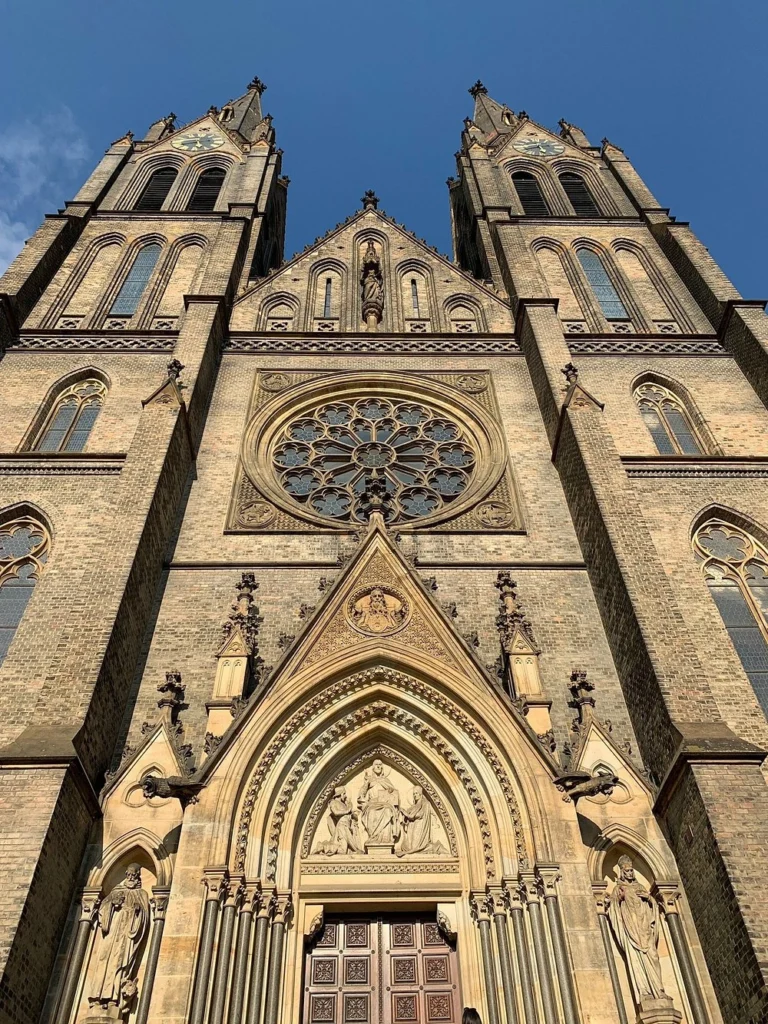
Artwork and Decorations on the Outside
More than twenty famous artists worked on the church’s paintings and sculptures. Above the main entrance, there’s a tympanum (that’s the space right over the doorway) sculpted by Josef Vaclav Myslbek. In this relief, Christ the Savior is blessing, while St. Ludmila and St.Wenceslas kneel before him. Right above the main door is that huge rose window I mentioned, and at the corners of the portal, you can find low-relief emblems of the four evangelists these were made by Josef Capek. The gables of both the main part of the church and the transept are decorated with statues of Czech patron saints. For example, St. Ludmila was sculpted by Ludvík Šimek, and St. Cyril and Methodius by Bernard Otto Seeling. Flanking the main portal, there are statues of St. Procopius by František Hergesel and St. Adalbert by Antonín Procházka. The lights on the staircase weren’t just ordinary they were electric lamps supplied by Frantisek Krizík, who was a well-known inventor and engineer at the time.

The Interior of the Basilica
Inside, the basilica is just as impressive. The Art Nouveau side altars were designed and made by Antonín Procházka and Štěpán Zálešák. Beautiful wood carvings were added by Jan Kastner, adding a warm, natural touch. Jan Jobst and other artists’ decorative paintings cover the walls. In the main nave, you’ll see paintings that show Czech patron saints. Up in the presbytery (the part near the altar), the ceiling vault is decorated with medallions of saints. At the far east end of the north nave, there are paintings showing scenes from the life of the Virgin Mary. On the south nave side, the paintings tell the story of St. Cyril and Methodius. One special spot is the Chapel of the Holy Cross. It was painted in 1933 by Marie Urbanová-Zahradnická, following designs made by her husband, František Urban.
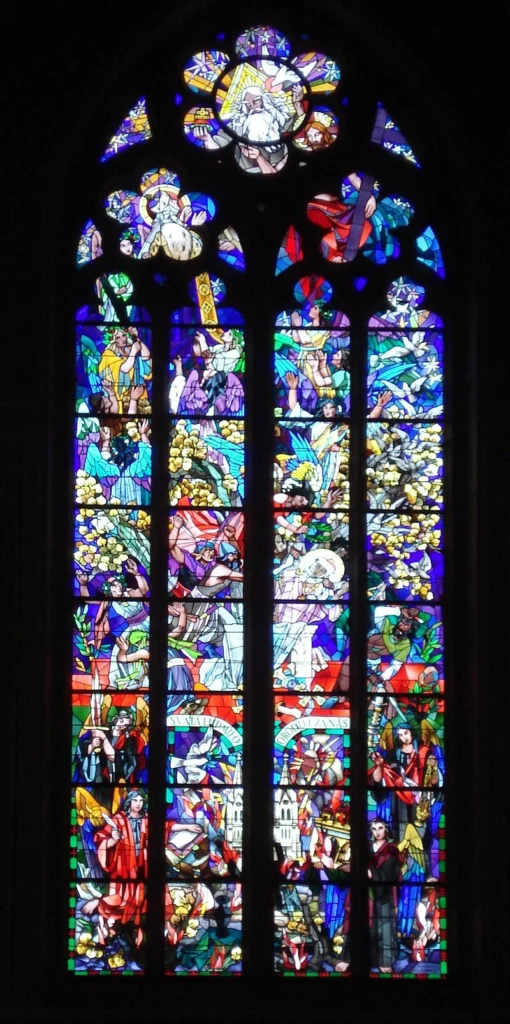
Stained Glass Windows and Color
The colors inside come a lot from the stained glass windows. These weren’t all made at once they were gradually created over time by various artists like František Sequens, Adolf Liebscher, František Urban, and Zikmund Rudl. Sadly, during World War II, the stained glass on the northern wall of the nave was destroyed. It was replaced in 1950 with a new window showing the martyrdom and assumption of St. Ludmila. Jaroslav Vodraák, an artist and illustrator, created this.
The Pulpit
The pulpit, where sermons are given, was designed by architect Josef Zika. Its sculptural decorations were done by Antonin Prochazka, adding to the rich artistic feel of the church’s interior.
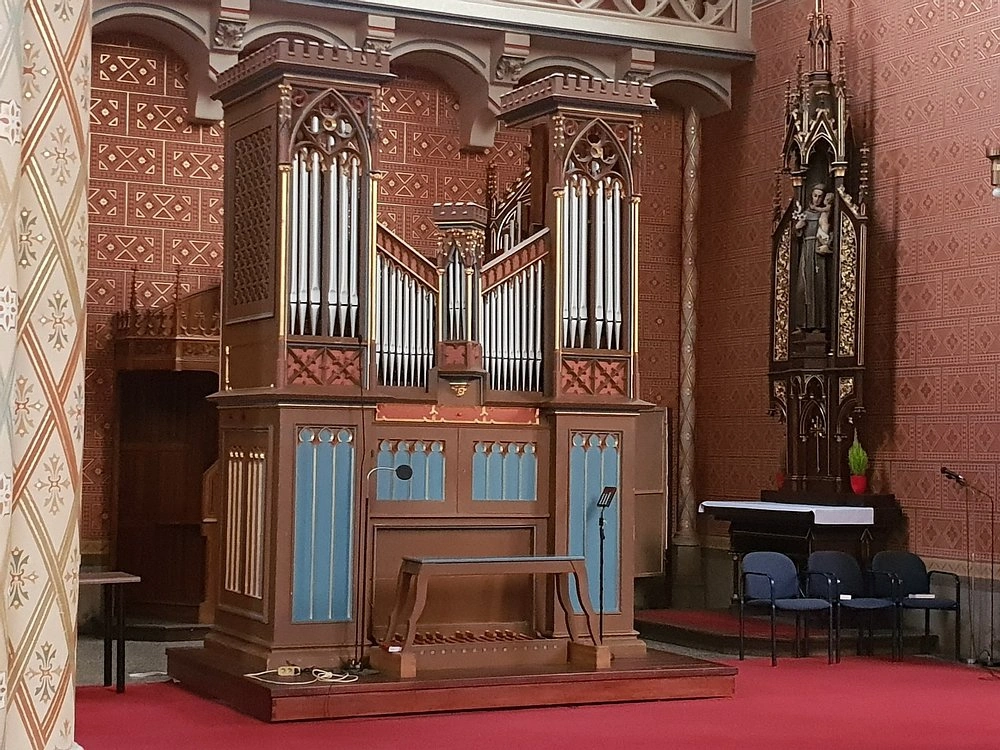
The Organ
The organ is a masterpiece on its own. It was finished in 1898, five years after the church was completed. Emanuel Stepan Petr was the organ builder, and this was his 117th work. The organ sits in the main choir and is housed in a beautifully carved oak cabinet designed in neo-Gothic style, which fits perfectly with the rest of the church’s look. Some people believe that Josef Mocker, the church’s architect, may have also designed the cabinet. An interesting fact: the front of the organ still has its original tin pipes. These survived the 1917 war metal requisition, when many metals were taken for the war effort. The organ works mechanically and uses a Barker lever to make playing easier. It wasn’t used from 2013 to 2018 because it was being renovated. Thanks to donations and public support, the organ was restored and is back in use today.
Feast Day
Feast Day : 16 September
The feast day of St. Ludmila is celebrated on September 16. She is the patron saint of the Basilica of St. Ludmila in Vinohrady, Prague. St. Ludmila was a duchess of Bohemia and the grandmother of St. Wenceslas. She is honored as a martyr and one of the earliest Czech saints. Each year, the basilica marks her feast with special church services and community events.
Church Mass Timing
Monday to Saturday : 04:30 PM
Sunday : 09:00 AM , 11:00 AM , 04:30 PM
Church Opening Time:
Monday to Saturday : 11:00 am – 4:00 pm
Friday : 11:00 am – 4:00 pm
Sunday : 8:30 am – 12:00 pm, 3:30 pm – 5:30 pm
Contact Info
Address : Basilica of Saint Ludmila
Náměstí Míru 1219/2, 120 00 Vinohrady, Czechia
Phone : +420 222 521 558
Accommodations
Connectivities
Airway
Basilica of St. Ludmila, Vinohrady, Czechia, to Václav Havel Airport Prague, distance 38 min (18.3 km) via Evropská.
Railway
Basilica of St. Ludmila, Vinohrady, Czechia, to The Main Train Station of Prague, distance between 7 min (2.0 km) via Vinohradská.

